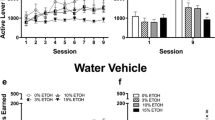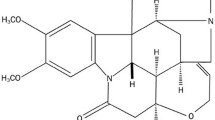Abstract
Rationale
The role of ethanol-derived acetaldehyde has not been examined yet on performance in a model of operant oral self-administration. However, previous studies reported that an acetaldehyde-sequestering agent, d-penicillamine (DP) and an inhibitor of catalase-mediated acetaldehyde production, 3-amino-1,2,4-triazole (3-AT) reduce voluntary ethanol consumption.
Objectives
The aim of our investigation was to evaluate the effects of DP and 3-AT on acquisition and maintenance of oral operant ethanol self-administration.
Methods
Using operant chambers, rats learned to nose poke in order to receive ethanol solution (5–10 % v/v) under an FR1 schedule of reinforcement in which discrete light and tone cues were presented during ethanol delivery.
Results
DP and 3-AT impair the acquisition of ethanol self-administration, whereas its maintenance is not affected neither by drug given alone for both 10 or 5 % ethanol nor by drugs association for 5 % ethanol. Moreover, when the concentration of ethanol was diminished from 10 to 5 %, rats increased the rate of self-administration behaviour.
Conclusions
These findings suggest that brain acetaldehyde plays a critical role during acquisition of operant self-administration in ethanol-naïve rats. In contrast, during the maintenance phase, acetaldehyde could contribute to ethanol self-administration by a combined mechanism: On one hand, its lack (by DP or 3-AT) might result in further ethanol-seeking and taking and, on the other, inhibition of ethanol metabolism (by 3-AT) might release an action of the un-metabolised fraction of ethanol that does not overall result in compromising maintenance of ethanol self-administration.





Similar content being viewed by others
References
Aragon CM, Amit Z (1992) The effect of 3-amino-1,2,4-triazole on voluntary ethanol consumption: evidence for brain catalase involvement in the mechanism of action. Neuropharmacology 31:709–712
Bienkowski P, Kostowski W, Koros E (1999) Ethanol-reinforced behaviour in the rat: effects of naltrexone. Eur J Pharmacol 374:321–327. doi:10.1016/S0014-2999(99)00245-9
Correa M, Miquel M, Sanchis-Segura C, Aragon CM (1999) Acute lead acetate administration potentiates ethanol-induced locomotor activity in mice: the role of brain catalase. Alcohol Clin Exp Res 23:799–805
Correa M, Salamone JD, Segovia KN, Pardo M, Longoni R, Spina L, Peana AT, Vinci S, Acquas E (2012) Piecing together the puzzle of acetaldehyde as a neuroactive agent. Neurosci Biobehav Rev 36:404–430. doi:10.1016/j.neubiorev.2011.07.009
Czachowski CL, Legg BH, Samson HH (2001) Effects of acamprosate on ethanol-seeking and self-administration in the rat. Alcohol Clin Exp Res 25:344–350. doi:10.1111/j.1530-0277.2001.tb02220.x
Davies M (2003) The role of GABAA receptors in mediating the effects of alcohol in the central nervous system. J Psychiatry Neurosci 28:263–274
Escarabajal D, Miquel M, Aragon CM (2000) A psychopharmacological study of the relationship between brain catalase activity and ethanol-induced locomotor activity in mice. J Stud Alcohol 61:493–498
Font L, Miquel M, Aragon CM (2005) Prevention of ethanol-induced behavioral stimulation by D-penicillamine: a sequestration agent for acetaldehyde. Alcohol Clin Exp Res 29:1156–1164
Font L, Aragon CM, Miquel M (2006a) Voluntary ethanol consumption decreases after the inactivation of central acetaldehyde by d-penicillamine. Behav Brain Res 171:78–86. doi:10.1016/j.bbr.2006.03.020
Font L, Aragon CM, Miquel M (2006b) Ethanol-induced conditioned place preference, but not aversion, is blocked by treatment with D -penicillamine, an inactivation agent for acetaldehyde. Psychopharmacology (Berl) 184:56–64. doi:10.1007/s00213-005-0224-z
Font L, Miquel M, Aragon CM (2008) Involvement of brain catalase activity in the acquisition of ethanol-induced conditioned place preference. Physiol Behav 93:733–741. doi:10.1016/j.physbeh.2007.11.026
Graham DL, Self DW (2010) Integrating behavioral and molecular approaches in mouse self-administration studies. In: Kuhn CM, Koob GF (eds) Advances in the neuroscience of addiction, vol Chapter 5, 2nd edn. CRC Press, Boca Raton, pp pp. 164–pp. 165
Grant KA, Samson HH (1986) The induction of oral ethanol self-administration by contingent ethanol delivery. Drug Alcohol Depend 16:361–368
Ingjaldsson JT, Thayer JF, Laberg JC (2003) Preattentive processing of alcohol stimuli. Scand J Psychol 44:161–165. doi:10.1111/1467-9450.00334
Israel Y, Quintanilla ME, Karahanian E, Rivera-Meza M, Herrera-Marschitz M (2015) The “first hit” toward alcohol reinforcement: role of ethanol metabolites. Alcohol Clin Exp Res 39:776–786. doi:10.1111/acer.12709
Kaminski BJ, Van Linn ML, Cook JM, Yin W, Weerts EM (2013) Effects of the benzodiazepine GABAA α1-preferring ligand, 3-propoxy-β-carboline hydrochloride (3-PBC), on alcohol seeking and self-administration in baboons. Psychopharmacology 227:127–136. doi:10.1007/s00213-012-2946-z
Karahanian E, Quintanilla ME, Tampier L, Rivera-Meza M, Bustamante D, Gonzalez-Lira V, Morales P, Herrera-Marschitz M, Israel Y (2011) Ethanol as a prodrug: brain metabolism of ethanol mediates its reinforcing effects. Alcohol Clin Exp Res 35:606–612. doi:10.1111/j.1530-0277.2011.01439.x
Karahanian E, Rivera-Meza M, Tampier L, Quintanilla ME, Herrera-Marschitz M, Israel Y (2015) Long-term inhibition of ethanol intake by the administration of an aldehyde dehydrogenase-2 (ALDH2)-coding lentiviral vector into the ventral tegmental area of rats. Addict Biol 20:336–344. doi:10.1111/adb.12130
Koechling UM, Amit Z (1994) Effects of 3-amino-1,2,4-triazole on brain catalase in the mediation of ethanol consumption in mice. Alcohol 11:235–239. doi:10.1016/0741-8329(94)90036-1
Kumar S, Porcu P, Werner DF, Matthews DB, Diaz-Granados JL, Helfand RS, Morrow AL (2009) The role of GABA(A) receptors in the acute and chronic effects of ethanol: a decade of progress. Psychopharmacology (Berl) 205:529–564. doi:10.1007/s00213-009-1562-z
Ledesma JC, Font L, Baliño P, Aragon CM (2013) Modulation of ethanol-induced conditioned place preference in mice by 3-amino-1,2,4-triazole and D-penicillamine depends on ethanol dose and number of conditioning trials. Psychopharmacology 230:557–568. doi:10.1007/s00213-013-3177-7
Ledesma JC, Baliño P, Aragon CM (2014) Reduction in central H2O2 levels prevents voluntary ethanol intake in mice: a role for the brain catalase-H2O2 system in alcohol binge drinking. Alcohol Clin Exp Res 38:60–67. doi:10.1111/acer.12253
Martí-Prats L, Sánchez-Catalán MJ, Orrico A, Zornoza T, Polache A, Granero L (2013) Opposite motor responses elicited by ethanol in the posterior VTA: the role of acetaldehyde and the non-metabolized fraction of ethanol. Neuropharmacology 72:204–214. doi:10.1016/j.neuropharm.2013.04.047
Nagasawa HT, Goon DJ, DeMaster EG (1978) 2,5,5-Trimethylthiazolidine-4-carboxylic acid, a D(-)-penicillamine-directed pseudometabolite of ethanol. Detoxication mechanism for acetaldehyde. J Med Chem 21:1274–1279. doi:10.1021/jm00210 a019
National Research Council (1996) Guide for the Care and Use of Laboratory Animals. National Academies Press, Washington, DC
Orrico A, Hipólito L, Sánchez-Catalán MJ, Martí-Prats L, Zornoza T, Granero L, Polache A (2013) Efficacy of D-penicillamine, a sequestering acetaldehyde agent, in the prevention of alcohol relapse-like drinking in rats. Psychopharmacology (Berl) 228:563–575. doi:10.1007/s00213-013-3065-1
Peana AT, Acquas E (2013) Behavioral and biochemical evidence of the role of acetaldehyde in the motivational effects of ethanol Front. Behav Neurosci 7:86. doi:10.3389/fnbeh.2013.00086
Peana AT, Enrico P, Assaretti AR, Pulighe E, Muggironi G, Nieddu M, Diana M (2008) Key role of ethanol-derived acetaldehyde in the motivational properties induced by intragastric ethanol: a conditioned place preference study in the rat. Alcohol Clin Exp Res 32:249–258. doi:10.1111/j.1530-0277.2007.00574.x
Peana AT, Muggironi G, Diana M (2010) Acetaldehyde- motivational effects; a study on oral self-administration behavior. Front Psychiatry 1:23. doi:10.3389/fpsyt.2010.00023
Peana AT, Muggironi G, Fois GR, Zinellu M, Sirca D, Diana M (2012) Effect of (L)-cysteine on acetaldehyde self-administration. Alcohol 46:489–497. doi:10.1016/j.alcohol.2011.10.004
Peana AT, Muggironi G, Fois G, Diana M (2013) Alpha- lipoic acid reduces ethanol self- administration in rats. Alcohol Clin Exp Res 37:1816–1822. doi:10.1111/acer.12169
Pelloux Y, Costentin J, Duterte-Boucher D (2015) Differential involvement of anxiety and novelty preference levels on oral ethanol consumption in rats. Psychopharmacology (Berl) Mar 13. [Epub ahead of print]
Samson HH, Pfeffer AO, Tolliver GA (1988) Oral ethanol self-administration in rats: models of alcohol-seeking behavior. Alcohol Clin Exp Res 12:591–598
Tomie A, Grimes KL, Pohorecky LA (2008) Behavioral characteristics and neurobiological substrates shared by Pavlovian sign tracking and drug abuse. Brain Res Rev 58:121–135. doi:10.1016/j.brainresrev.2007.12.003
U.S. Pharmacopeia National Formulary (1995) Alcoholmetric Table Based on Data in the National Bureau of Standard Bulletin, Vol. 9. Rand McNally, Taunton, MA, pp 424-425
Acknowledgments
This work was supported through grants from Fondazione Banco di Sardegna (Sassari, Italy) to ATP (2013).
This study was carried out in accordance with the Italian legislation (D.L. 116, 1992), which allowed experimentation on laboratory animals only after submission and approval of a research project to welfare and health organisation on animal’s experimentation of the University of Sassari (Sassari, Italy) and to the Ministry of Health (Rome, Italy), and in accordance with European Council directives on the matter (n. 2007/526/CE) and the “Guide for the care and use of laboratory animals” as approved by the Society for Neuroscience (National Research Council 1996).
Conflict of interest
None declared.
Author information
Authors and Affiliations
Corresponding author
Rights and permissions
About this article
Cite this article
Peana, A.T., Porcheddu, V., Bennardini, F. et al. Role of ethanol-derived acetaldehyde in operant oral self-administration of ethanol in rats. Psychopharmacology 232, 4269–4276 (2015). https://doi.org/10.1007/s00213-015-4049-0
Received:
Accepted:
Published:
Issue Date:
DOI: https://doi.org/10.1007/s00213-015-4049-0




